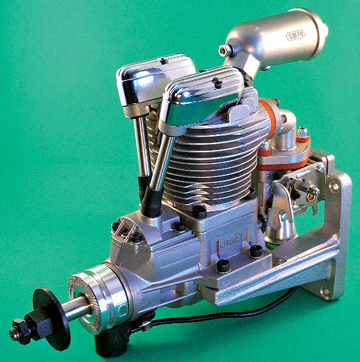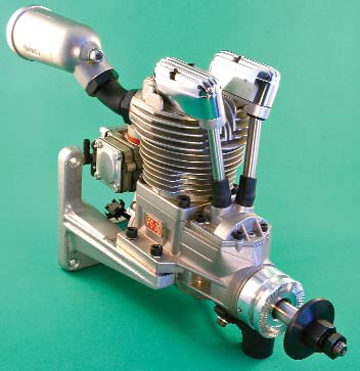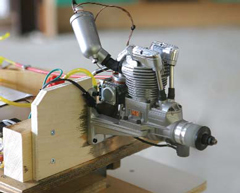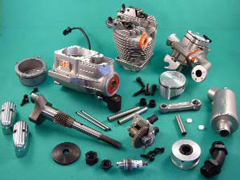| FLY RC | ENGINE REVIEW | by Thayer Syme |

Saito has concentrated its design and manufacturing efforts for many years on four stroke model engines and it has paid off. It have established a worldwide reputation for lightweight, totally reliable and powerful engines. From the small .30 cu. in. single, to the large 450 radial, it produces a wide range of displacements with many cylinder configurations. The 1.80 single is one of the largest, single-cylinder four strokes available and has developed a following in the giant scale crowd for its power and handling. With the release of the FG-30, the 1.80 is converted for gasoline. This is certainly more economical and with the integrated spark ignition, it becomes very docile and more user-friendly. The FG-30 follows the traditional Saito practice of a one piece head/cylinder and shares other Saito characteristics as we will see, along with a few innovative modifications necessary for running a gasoline/oil mix.
INITIAL IMPRESSIONS
Although I have never reviewed the 1.80 glow version, I was extremely excited to get my hands on the FG-30, as I have seen several of these in fellow fliers aircraft. I was also interested in seeing how the interior compared to that of the FG-36, which I did review a few years ago in Fly RC. (find.flyrc.com/061122)
 The engine comes wonderfully packaged in typical Saito fashion, nestled in a white heavy cardstock box with custom cut dense foam packaging. In this case, it also comes bolted to the engine mount. I know a lot of modelers dont really care how their engines are packaged, but the Saito really exudes a quality and classy look from the moment you get the box in your hands! Inside, the clean and wrapped engine/mount is well protected from any shipping damage. Also included are an adjustment wrench for the muffler nuts, the muffler and stack, a spark plug socket, bagged mounting hardware, a feeler gauge and tools for valve adjustment, the ignition unit and, of course, a quality instruction/operation manual. Lots of goodies to look at and go through!
The engine comes wonderfully packaged in typical Saito fashion, nestled in a white heavy cardstock box with custom cut dense foam packaging. In this case, it also comes bolted to the engine mount. I know a lot of modelers dont really care how their engines are packaged, but the Saito really exudes a quality and classy look from the moment you get the box in your hands! Inside, the clean and wrapped engine/mount is well protected from any shipping damage. Also included are an adjustment wrench for the muffler nuts, the muffler and stack, a spark plug socket, bagged mounting hardware, a feeler gauge and tools for valve adjustment, the ignition unit and, of course, a quality instruction/operation manual. Lots of goodies to look at and go through!
Everything arrived intact and in pristine condition. The Saito exterior looks brilliant, with a fine beadblast finish. The casting quality is perfect, as is all exterior machine work. The most noticeable difference between that of the FG-30 and the FA-1.80 glow is the replacing of the glow carb with a gas pumper-style carb (similar to some of the Walbro offerings), the head being tapped for an NGK-CM6 spark plug instead of a regular 1/4-32 glow plug, and the larger size muffler.
One other neat thing I noticed almost immediately is that the carb already comes with a ball linkage installed, and it is a straight pull linkage! The throttle hook up couldnt be easier on this engine!
RUNNING THE ENGINE
The included instruction booklet is excellent, giving precise instructions on all aspects of break in and running. The first thing to note is that the engine is designed to be run only with the included aluminum mount. The mount acts as a heat sink, transferring heat away from the engine and if run without it, you may have issues with the engine overheating.
Fuel can be any regular or unleaded gasoline, mixed in a 20:1 ratio with a quality brand of air-cooled, two-stroke synthetic motor oil. I chose Mobil two-stroke oil, as it is a proven full synthetic oil that I have used in several engines in the past. Unlike previously, the break in and long term running is to be done on the 20:1 fuel mix without going to a lower oil ratio.
For break in, the ignition unit is plugged in and powered by a 4 or 5-cell NiCd or NiMH or 2S LiPo pack of at least 1000mAh capacity. A 16-inch prop is recommended for break in, and of course make sure all fuel tank/bung/lines are gasoline compatible. I used an APC 16×8 prop.
 Around the time of my tests, the temperature was 58 F, humidity high at 79% and pressure was 29.7 inches of mercury and rising. I am at just shy of 1000 FASL. I measured my engines cylinder head and exhaust temperatures with the Eagle Tree data telemetry system. I used the Eagle Tree system to give me the rpm as well, with all information displayed on their LCD display unit. I confirmed the rpm readings with my Glowbee hand held tachometer.
Around the time of my tests, the temperature was 58 F, humidity high at 79% and pressure was 29.7 inches of mercury and rising. I am at just shy of 1000 FASL. I measured my engines cylinder head and exhaust temperatures with the Eagle Tree data telemetry system. I used the Eagle Tree system to give me the rpm as well, with all information displayed on their LCD display unit. I confirmed the rpm readings with my Glowbee hand held tachometer.
Once set up on my test stand, I tried to start the FG-30. After several minutes of unsuccessful attempts to start the engine, a fellow flier suggested I open the carb slightly more than I had it set. Bingo! It started up immediately. It seems the carb linkage needs to be moved quite a bit off the stop limit before the carb barrel reaches the idle position. Keep that in mind, and it reminded me that sometimes another person can suggest a simple fix to a problem created by the user. Again, this was a fault of mine and in no way a problem with the engine.
After I figured where to set the carb for idle, I easily hand started the engine after turning the engine through compression a number of times to prime the fuel line. The booklet states electric starting is the preferred method, but with the docile characteristics of a quality autoadvancing ignition unit, hand starting is easy and I recommend it (but please still use a glove as some props have sharp edges). For the first 10 minutes of running, it is recommended you do not exceed 4,000 rpm. After I commenced with throttling the engine up to higher speeds, I noticed the carb was very well set from the factory. Almost no adjustment was necessary (although I did lean the high end and idle adjustment slightly after some more run time was accumulated)! No mention of more extensive run time is required before flying, or in my case prop testing, so I proceeded with the prop testing.
Here are my results obtained while running in the engine: Although the engine is capable of running large props effectively without overheating or back firing, the recommended static rpm is approximately 8,300 to 9,000. The 16×8 and 17×6 were the two props the engine seemed happiest with. Also, keep in mind that the engine can still start to pre detonate if set too lean.
Throughout all the bench tests, the engine behaved perfectly, with easy one or two flip starts. This engine was actually purchased by Thayer Syme and he will soon flight test it in a quarter-scale model he has, thus no flight testing was performed by myself.
| Run | Max CHT | Max EGT | Max RPM | Idle | |
| Degrees F | Degrees F | ||||
| 10 Minutes | 148 | 240 | 3,250-3,800 | 2,100 | |
| Propeller | Max RPM | Max CHT | Max EGT | Idle | Thrust at Max RPM |
| Degrees F | Degrees F | Kgs/lbs. | |||
| APC 16X8 | 8,920 | 361 | 576 | 2,100 | 6.5/14.30 |
| APC 16X10 | 8,150 | 364 | 555 | 2,100 | 6.7/14.74 |
| APC 17X6 | 8,800 | 374 | 575 | 2,100 | 7.2/15.84 |
| APC 17X8 | 8,040 | 371 | 557 | 2,100 | 6.8/14.96 |
| APC 17X10 | 7,300 | 389 | 561 | 2,100 | 6.3/13.86 |
MOUNTING DIMENSIONS
FG-30 has the following dimensions, all in inches: 31/4 from the prop drive face to the centerline of the cylinder, 61/4 from the prop drive face to the rear of the mount (with an additional 1/2 needed to clear the carburetor rear surface). 41/2 is the height from the crank center line to the top of the rocker covers. The width of the beam mounts is 23/4, with the hole spacing at 25/16.
|
Disassembling the FG-30 poses few issues. It is in fact in some ways easier than working on a smaller engine owing to the larger size of the components. I do however, recommend that you let the pros at Horizon Hobbys service department handle the repair work, especially while still under warranty unless you are 100-percent comfortable working on such a finely crafted engine. The crankcase is a lovely aluminum casting. Housing the rear (open) and front (sealed) ball bearings, its insides are obviously CNC machined, as the work is flawless. The exterior is given a fine glass bead blasting finish, which has a very shiny appearance and looks great. Not a single casting flaw was apparent. The backplate is also of cast aluminum, and given the same treatment on the exterior. There is a paper gasket to seal against oil leaks, something not often seen in a four stroke. The cast aluminum head and cylinder are a single unit, manufactured identically to smaller displacement Saitos. The interior is given a true chrome plating”making this an AAC type engine, with a ring. The single intake and exhaust poppet valves are the same size, and places symmetrically in the hemispherical combustion chamber. The head is bored for a CM-6 spark plug. The beefy crankshaft is a single piece steel forging. The crank is beautifully machined with a solid crank pin, and dual cutaway counter balance. The main journal of the shaft has been drilled for lightness. The cast aluminum piston has a single unpinned cast-iron ring. The skirt features a dual cutaway for clearing the crankshaft counter balance. There are also two machined areas for valve clearance on the top, preventing any contact between the valves and the piston at high rpm. The tubular steel wrist pin rides in un-bushed bosses cast into the piston. Two Teflon pads prevent contact between the free floating wrist pin and the cylinder wall.
The valves and valve train follow typical practice, by using two similar sized steel valves (one each for the intake and exhaust). The springs are held on with split, tapered collets, like some full-size automotive engines use. The single piece cam gear/cam lobe unit rides on a steel shaft, transferring the motion via hardened steel cam followers, which run in bronze bushings. The tubular steel pushrods have hardened ends and run in tubular push rod covers, and transfer movement from the followers to the rocker arms. The rocker arms are steel castings, pivoting on a thread in place steel pin. Adjustment for the valves is by a setscrew and locking nut. The vast valve covers are chrome plated and sealed with a paper gasket. The prop hub has an embedded magnet, which triggers the hall effect sensor mounted on the lower front end of the crank case. The hub is machined from bar stock aluminum, and held in place with steel split tapered collet, and a set screw”the set screw engaging into a slot in the crankshaft, which will guarantee the ignition timing does not change. The prop washer and locking nuts are steel, with a black oxide finish. The carburetor is a two-needle design, with a diaphragm pump similar to a Walbro carb. It uses a rotating barrel design, with a plastic barrel and an aluminum housing. A cast aluminum elbow connects the carb to the head/intake, and an aluminum velocity stack on the intake side rounds out the system. There are phenolic spacers that prevent any heat transfer to the carburetor. The baffled muffler is identical to that provided with the FG-36 and is machined from aluminum castings. A threaded steel elbow and locking nuts allows positioning the muffler in any location needed. The pressure nipple is also absent and the hole blocked, as no pressure is required with a pumping carburetor. |
|
ENGINE: FG-30 MANUFACTURER: Saito Engines, Japan DISTRIBUTOR: Horizon Hobby Inc. DISPLACEMENT: 1.80 ci / 29.1 cc WEIGHT: 53.3 oz. with supplied header and muffler, aluminum mount, and ignition unit TYPE: Four stroke gas engine PROP RANGE: 16×8 to 18×6 for normal sport/aerobatic flying STREET PRICE: $639.99 SUMMARY: The FG-30 is Saitos spark ignition, gasoline version of its famous 1.80 four stroke, a winner when it comes to big, single cylinder glow power. The FG-30 sips fuel at an incredibly low rate, can swing a wide range of props and do it with the utter reliability that is a Saito hallmark. Unlike typical two-stroke gassers, the sweet four-stroke sound can and will add realism to any model. Superb idle and transition round out the near perfect package. In my opinion, the FG-30 will find a home in many large scale planes, happily flying full-blown 3D aerobats to swinging big props in a scale ship; the engine can meet and exceed your expectations. Backed by Horizons three-year warranty (the best in the business for four strokes) and excellent service, its a winner all around! |
CONCLUSION
Much like the case with the FG-36, Saito has taken another proven glow engine and has given the modeling world a great gas burning alternative with the FG-30. The engine produces approximately the same amount of power, with the ease and reliability of a wellbehaved spark ignition system. No longer do you have to spend money on expensive glow fuel either! The easy-to-handle FG-30 is suited for scale, sport, aerobatic and Sunday flyer types equally. Great throttle ability and low fuel consumption are two of its other key features. And finally, a low exhaust note that will be accepted at even the strictest of flying fields make this one a winner in every respect! I guarantee you wont be disappointed in choosing the Saito FG-30 for your next model!
|
APC Propellers distributed by Landing Products, www.apcprop.com , (530) 661-0399 Saito Airplane Engines distributed by Horizon Hobby Distributors, www.horizonhobby.com , (800) 338-4639 |
 Fly RC Magazine WE LIVE RC
Fly RC Magazine WE LIVE RC
 The connecting rod is an aluminum casting, without bronze bushings on either end (unlike the bushed FG-36) but with a similar slotted lower end, like the FG-20. Along with the slot, there is a single oil hole on the upper end to make sure enough lubrication reaches the crank and wrist pin areas.
The connecting rod is an aluminum casting, without bronze bushings on either end (unlike the bushed FG-36) but with a similar slotted lower end, like the FG-20. Along with the slot, there is a single oil hole on the upper end to make sure enough lubrication reaches the crank and wrist pin areas.